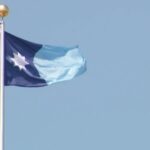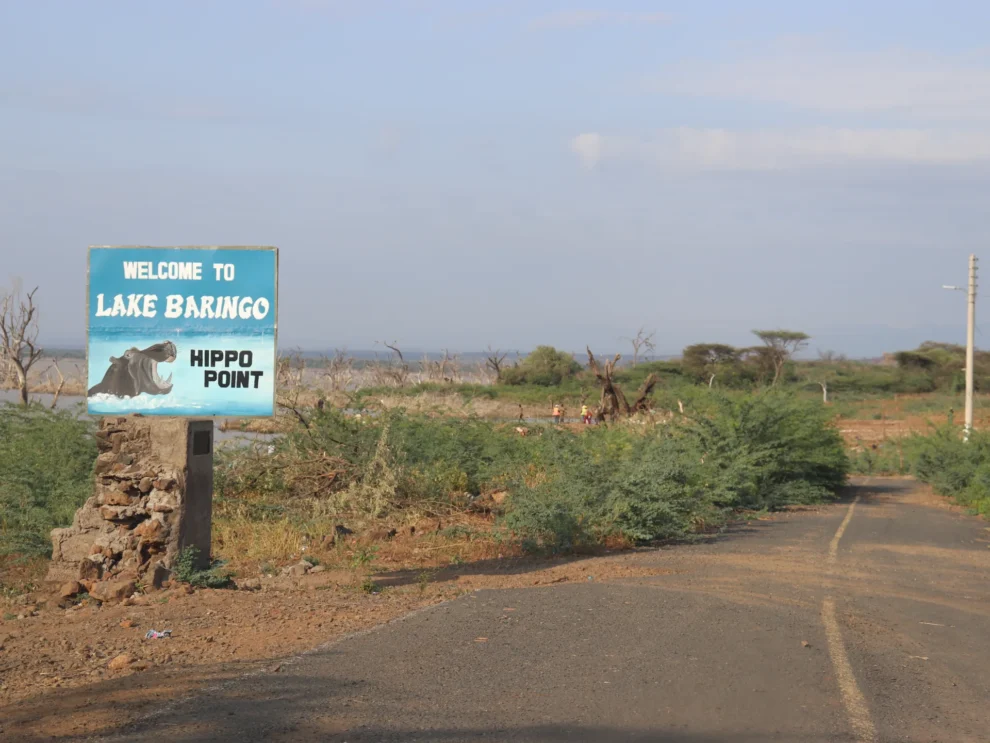For a decade, water in Kenya’s Rift Valley has been rising due to climate change. The displaced say they want normalcy.
Loboi, Kenya – Ruth Kentyenya has just finished cutting vegetables as the lakeside evening breeze wafts over her village, Loboi, on the shores of Lake Bogoria. As she waits for her daughter to come back from the market and cook dinner, she sweeps the house.
But the 83-year-old’s calm demeanour is at odds with the state of Loboi, 5km (3 miles) from the lake’s source and partly submerged in water.
“We used to farm here,” Kentyenya said, referring to her previous home grounds on a plain from which rising lake waters forced 50 families, including hers, about 200 metres uphill, to the Lake Bogoria National Park. “[But] we had to obey nature. It took away the farms we used to depend on … and freshwater from River Waseges to water our crops and [for] animals, and for household use, including drinking. Now we only have [salty] lake water.”
Lake Bogoria, in the Kenyan Great Rift Valley, lies in a half-graben basin south of Lake Baringo, a few kilometres north of the equator.
Kentyenya and her fellow residents now drink saline water as they are cut off from the freshwater of River Waseges that rises on the slopes of the Aberdare Ranges and drains into the Rift Valley, pouring into Bogoria.
Worse still, they have to fight off wild animals that come to disturb them and animals in their husbandry. Leopards hunting for prey and hippopotamuses coming to graze at night are now some of their new neighbours.

Settling in a new home
Kentyenya is from the minority Endorois community, a pastoralist community in the Rift Valley region. They were evicted from the area in the 1970s by the Kenyan government so it could set up the national reserve.
The Great Rift Valley is the most populous region in Kenya, home to a quarter of the population, as per the latest census in 2019. The area is a multiethnic society with the Maasai and Kalenjin, which the Endorois belong to, forming the majority.
Just like the Maasai, the Kalenjins were predominantly herders, but over the years, they have become mixed farmers, cultivating crops and maintaining their livestock.
For the past decade, water in Kenya’s Rift Valley has been rising. Scientists say this is due to climate change, wrong use of land, and a movement of tectonic plates inside the earth’s surface. This rise has moved the Endorois into the national park where they now stay.
In June, Kentyenya’s husband died but the family had trouble finding a place to bury him because they were not allowed to bury him inside the park.
“We had to go about 6km away from here for us to find a place to bury him,” Kentyenya said. Our relatives offered us a grave site on their land.”
Now, the Endorois living inside the park cannot farm in it and have been forced to find an alternative way of fending for themselves and their families by doing menial jobs on other people’s farms and beekeeping.
“As government, we are trying [to] find a legal way to settle the people, both through the county and national parliaments,” James Kimaru, a senior warden of the Kenya Wildlife Service (KWS) at the park, says.
Kimaru said it would not be easy for one entity to relocate the people alone, and that is why KWS is seeking approval either through the National Assembly or the county assembly.
Approximately 30km (18.5 miles) north of Loboi, the Njemps, another minority community, live in a village named Kiwanja Ndege, once an airstrip. The Njemps were also moved by the rising water in Lake Baringo and say their livelihood has been disrupted too.
According to a 2021 study led by researchers at the University of Natural Resources and Life Science in Vienna, the water in Lake Baringo covered an area of 118 square km (45.5sq miles) in 1995. As of 2020, it had expanded to 195sq km (75.3sq miles).
Experts say the rising waters in Rift Valley lakes are caused by water flowing from the lakes through underground channels that have reduced due to the movement of tectonic plates, as well as irresponsible land use in farming that has led to silting of soil into the lakes, blocking the channels and causing the water to rise.
“Underground seepage, the only outflow from the endorheic lakes, has been reduced by tectonic activities in the geologically highly active Rift Valley,” Matthew Herrnegger, the lead author of the study, told Al Jazeera. “Anthropogenic land degradation, leading to higher erosion and siltation rates, is also argued to have resulted in potential sealing and clogging of the underground water paths and also increased flow towards the lakes.”
The rise has disrupted livelihoods, and natural tourist attractions such as the hot water springs that Lake Bogoria was known for. However, smaller springs have developed about 10km from the previous ones, attracting fewer tourists.
Festus Tuya, Loboi’s chief, says the national government has been slow in compensating the people.
“We have taken the names of those affected and now live in the national park to the county government, who are to coordinate with the national government to compensate the people so they can go elsewhere and buy land … the government has been slow on this. These people are in danger,” Tuya told Al Jazeera English.

An uncertain future
When Kentyenya was a child, her parents told her stories of how the lake stretched beyond her home village and would one day find its way to its original “home”.
Herrnegger confirms this. “[Some] 8,000-10,000 years ago, lake levels were significantly higher than now … Lake Bogoria and Lake Baringo were also connected as one lake,” he said. “Has a maximum water level been reached or will the lake levels further increase? We don’t know. We also don’t know how long the current wetter conditions will persist.”
Brian Waswala, who works with Kenya’s National Commission for UNESCO, says the rising lake waters in the Rift Valley are due to several factors.
This movement squeezes out water from below-ground aquifers, causing the lakes to increase in volume. The tectonic cycle usually takes between 25 and 40 years, with the present cycle noted to have commenced in 1996. Climate change has also increased the water quantity the lakes might be unable to hold.
Waswala adds that the situation is worsened by human-induced habitat degradation, especially in the highlands, making the lakes shallow. At the peak of the tectonic cycle, the Rift Valley lakes might dry out.
“Food insecurity and water scarcity will be rife … health challenges from vectors, diets, and stress incidents will spike upwards; emigration rates will be witnessed and this will affect youth, women, marginalised communities, elderly, and people with disabilities bearing the most brunt; and biodiversity lost especially since human interest will come first as compared to other forms of life,” Waswala said.
Analysts say with the promotion of sustainable consumption and production patterns in tandem with ecosystem management, things could improve.
Meanwhile, the Endorois and the Njemps can hardly wait for the water to recede so they can go back to farming.
“Do you think we wronged God?” Kentyenya asks. “Can’t he allow us back home so we can be alive again?”
Source : Al Jazeera
















